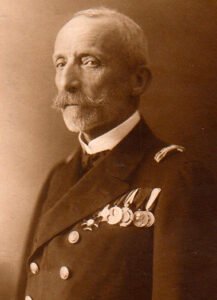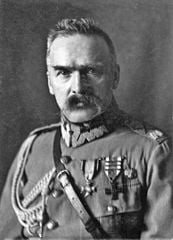German Puppet State Passport Krolestwo Polskie
German Puppet State Passport Krolestwo Polskie
The following travel document is passport history at its finest. I have to admit I didn’t know this part of German/Polish history, but sometimes you see something, you dig deeper and then suddenly I was enlightened. The passport was issued by the Kingdom of Poland, a proposed puppet state of the German Empire during World War I.¹
This document is most likely one of its kind, a passport of a state which existed only for an eye blink on the timeline of history!
On November 5th, 1916 the German Emperor William II and the Emperor Franz Joseph I of Austria issued the ‘Act of 5 November’ creating the Kingdom of Poland as an independent State with a hereditary monarchy. However, it did not have a government, and its borders were not yet defined. A state bank was established in Dec. 1916, which issued coins and paper money. Charles Stephen was considered as a candidate to be regent and eventually king.

At the time Charles Stephen was living at the Castle of Saysbusch (Żywiec), in Galicia. His chances were enhanced by the fact that he spoke fluent Polish. Two of his daughters were married to Polish princes belonging to the noble houses of Radziwill and Czartoryski. However, as Charles Stephen was a member of the Imperial House of Austria he needed permission to become king from the head of the family, Emperor Charles I, who hesitated, having himself planned to assume the Polish crown.
Moreover, the Radziwill and Czartoryski families urged the cause of Russia (as their ancestors had in the 18th century). Adding to the political muddle was the support of Ukrainian nationalism by Charles Stephen’s son, Archduke Wilhelm. In the end, the proclamation was so vague and tentative that it failed to inspire enthusiasm among its supposed beneficiaries or even among the Germans and Austro-Hungarians themselves.

On January 17th, 1917 a provisional state council was established, with J. Pilsudski as a member. Pilsudski, had stopped to collaborate with the interim state council and with the Germans and had been arrested.
The decision to propose the restoration of Poland after a century of partitions was taken up by the Germans in an attempt to legitimize further imperial omnipresence in the occupied territories. The plan was followed by the German propaganda delivered to the Poles in 1915, claiming that the German soldiers were arriving as liberators to free Poland from subjugation by Russia. A draft constitution was proposed in 1917. The German government used punitive threats to force Polish landowners living in the German-occupied Baltic states to relocate and sell their Baltic property to the Germans in exchange for the entry to Poland. Parallel efforts were made to remove Poles from Polish territories of the Prussian Partition.
In October 1917, a regular government was installed in the Kingdom of Poland, the Polish state becoming a reality. With the Russian Revolution going on, the 3 Polish corps in the Russian Army refused to place themselves under Bolshevik command and, in early 1918, protected the Minsk region from Bolshevik incursions. Soon the area was occupied by German forces, and the Polish Corps was dissolved. With Germany surrendering on November 11,1918 – the GERMAN REVOLUTION had broken out on Nov. 8th, the republic been proclaimed on Nov. 9th, a POLISH REPUBLIC took shape within days, comprising of Russian Poland and Western Galicia.




The Passport
A booklet with black linen softcover, without COA. A total of eight pages, 10,5 cm x 16,5 cm. The passport was issued by the central committee of the Kingdom of Poland on 15 June 1918 in Petrograd to Geologist Leon Werner, who is shown on the passport photo in uniform and with eyeglasses. The passport has the number 217. On page seven is a stamp from Warsaw, dated 13 Dec 1918. Leon Werner was born in 1869, which made him 49 years old when the passport was issued. He lived in Warsaw and was catholic. The document is in Polish and Russian language.




Leon W. was a citizen of Poland and worked on the territory of Imperial Russia, in the photograph we see him in the uniform of a Russian official, as an officer in the Union of Polish Military in Russia 1917-1918. In 1926 he was awarded for being a member of this organization.
I have never seen this passport-type before as it is a pretty rare one. Only the “WARSZAWA1939.PL” FOUNDATION has such a document online. Digging into history to learn more about passports is another fascinating aspect when collecting such documents. What a great find!
¹ The Kingdom of Poland has been referred to as a puppet state by several Historians like Norman Davies in Europe: A history (Google Books, p. 910); by Jerzy Lukowski and Hubert Zawadzki in A Concise History of Poland (Google Books, p. 218); by Piotr J. Wrobel in Chronology of Polish History and Nation and History (Google Books, p. 454); and by Raymond Leslie Buell in Poland: Key to Europe (Google Books, p. 68: “The Polish Kingdom… was merely a pawn [of Germany]”).
German Puppet State Passport Krolestwo Polskie
FAQ Passport History
Passport collection, passport renewal, old passports for sale, vintage passport, emergency passport renewal, same day passport, passport application, pasaporte passeport паспорт 护照 パスポート جواز سفر पासपोर्ट
1. What are the earliest known examples of passports, and how have they evolved?
The word "passport" came up only in the mid 15th Century. Before that, such documents were safe conducts, recommendations or protection letters. On a practical aspect, the earliest passport I have seen was from the mid 16th Century. Read more...
2. Are there any notable historical figures or personalities whose passports are highly sought after by collectors?
Every collector is doing well to define his collection focus, and yes, there are collectors looking for Celebrity passports and travel documents of historical figures like Winston Churchill, Brothers Grimm, Johann Wolfgang von Goethe. Read more...
3. How did passport designs and security features change throughout different periods in history, and what impact did these changes have on forgery prevention?
"Passports" before the 18th Century had a pure functional character. Security features were, in the best case, a watermark and a wax seal. Forgery, back then, was not an issue like it is nowadays. Only from the 1980s on, security features became a thing. A state-of-the-art passport nowadays has dozens of security features - visible and invisible. Some are known only by the security document printer itself. Read more...
4. What are some of the rarest and most valuable historical passports that have ever been sold or auctioned?
Lou Gehrig, Victor Tsoi, Marilyn Monroe, James Joyce, and Albert Einstein when it comes to the most expensive ones. Read more...
5. How do diplomatic passports differ from regular passports, and what makes them significant to collectors?
Such documents were often held by officials in high ranks, like ambassadors, consuls or special envoys. Furthermore, these travel documents are often frequently traveled. Hence, they hold a tapestry of stamps or visas. Partly from unusual places.
6. Can you provide insights into the stories behind specific historical passports that offer unique insights into past travel and migration trends?
A passport tells the story of its bearer and these stories can be everything - surprising, sad, vivid. Isabella Bird and her travels (1831-1904) or Mary Kingsley, a fearless Lady explorer.
7. What role did passports play during significant historical events, such as wartime travel restrictions or international treaties?
During war, a passport could have been a matter of life or death. Especially, when we are looking into WWII and the Holocaust. And yes, during that time, passports and similar documents were often forged to escape and save lives. Example...
8. How has the emergence of digital passports and biometric identification impacted the world of passport collecting?
Current modern passports having now often a sparkling, flashy design. This has mainly two reasons. 1. Improved security and 2. Displaying a countries' heritage, icons, and important figures or achievements. I can fully understand that those modern documents are wanted, especially by younger collectors.
9. Are there any specialized collections of passports, such as those from a specific country, era, or distinguished individuals?
Yes, the University of Western Sidney Library has e.g. a passport collection of the former prime minister Hon Edward Gough Whitlam and his wife Margaret. They are all diplomatic passports and I had the pleasure to apprise them. I hold e.g. a collection of almost all types of the German Empire passports (only 2 types are still missing). Also, my East German passport collection is quite extensive with pretty rare passport types.
10. Where can passport collectors find reliable resources and reputable sellers to expand their collection and learn more about passport history?
A good start is eBay, Delcampe, flea markets, garage or estate sales. The more significant travel documents you probably find at the classic auction houses. Sometimes I also offer documents from my archive/collection. See offers... As you are already here, you surely found a great source on the topic 😉
Other great sources are: Scottish Passports, The Nansen passport, The secret lives of diplomatic couriers
11. Is vintage passport collecting legal? What are the regulations and considerations collectors should know when acquiring historical passports?
First, it's important to stress that each country has its own laws when it comes to passports. Collecting old vintage passports for historical or educational reasons is safe and legal, or at least tolerated. More details on the legal aspects are here...
Does this article spark your curiosity about passport collecting and the history of passports? With this valuable information, you have a good basis to start your own passport collection.
Question? Contact me...

